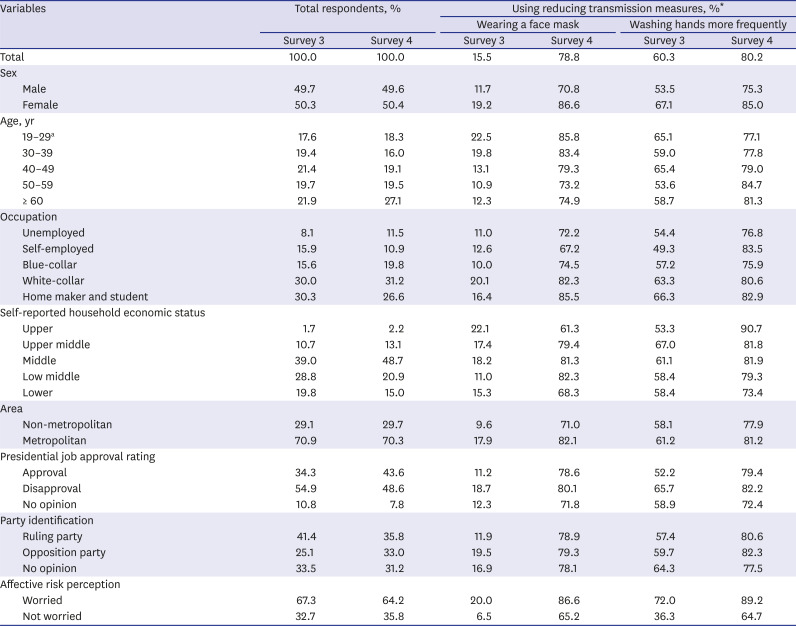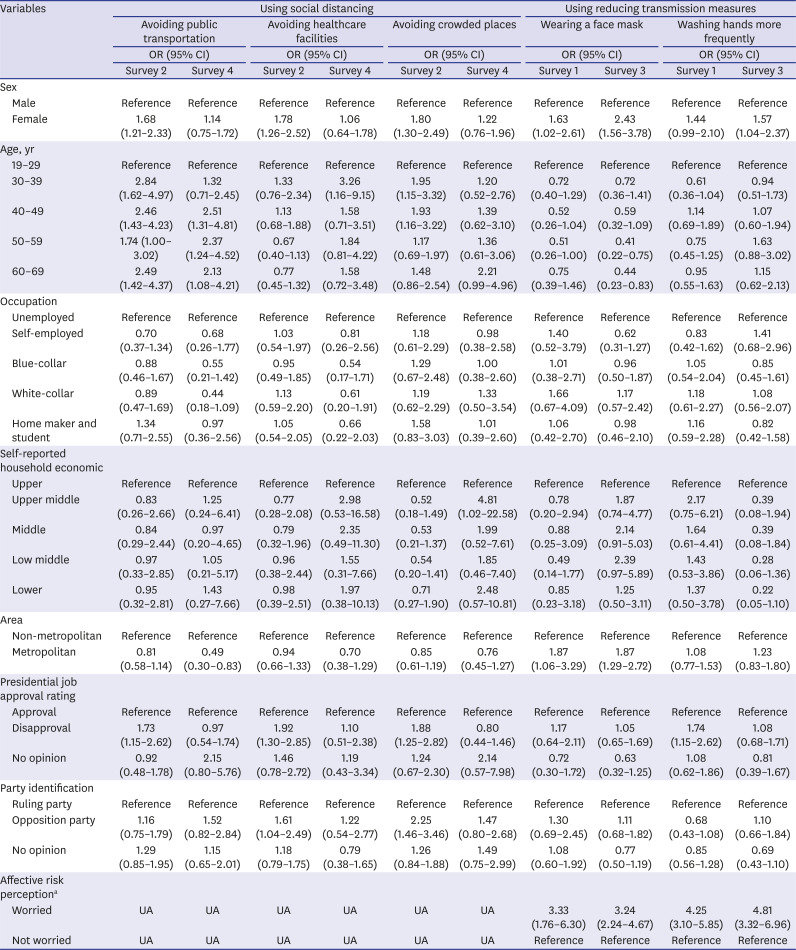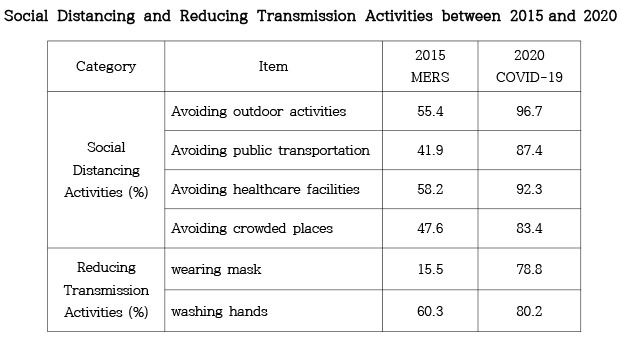2. Cowling BJ, Ali ST, Ng TWY, Tsang TK, Li JCM, Fong MW, et al. Impact assessment of non-pharmaceutical interventions against coronavirus disease 2019 and influenza in Hong Kong: an observational study. Lancet Public Health. 2020; 5(5):e279–e288. PMID:
32311320.

3. Prem K, Liu Y, Russell TW, Kucharski AJ, Eggo RM, Davies N, et al. The effect of control strategies to reduce social mixing on outcomes of the COVID-19 epidemic in Wuhan, China: a modelling study. Lancet Public Health. 2020; 5(5):e261–70. PMID:
32220655.
4. Wölfel R, Corman VM, Guggemos W, Seilmaier M, Zange S, Müller MA, et al. Virological assessment of hospitalized patients with COVID-2019. Nature. 2020; 581(7809):465–469. PMID:
32235945.

5. Noh JY, Seong H, Yoon JG, Song JY, Cheong HJ, Kim WJ. Social distancing against COVID-19: implication for the control of influenza. J Korean Med Sci. 2020; 35(19):e182. PMID:
32419400.

6. Na BJ, Park Y, Huh IS, Kang CR, Lee J, Lee JY. Seventy-two hours, targeting time from first COVID-19 symptom onset to hospitalization. J Korean Med Sci. 2020; 35(20):e192. PMID:
32449328.

7. Fung IC, Cairncross S. Effectiveness of handwashing in preventing SARS: a review. Trop Med Int Health. 2006; 11(11):1749–1758. PMID:
17054756.

8. Tracht SM, Del Valle SY, Hyman JM. Mathematical modeling of the effectiveness of facemasks in reducing the spread of novel influenza A (H1N1). PLoS One. 2010; 5(2):e9018. PMID:
20161764.

9. Park EC. Central government reform to improve national disease control. J Korean Med Assoc. 2015; 58(8):714–722.

10. Song DY, Lee WK. Severe acute respiratory syndrome, SARS. Korean J Clin Microbiol. 2005; 8(2):105–112.
11. Choi JK, Lee SW, Choi BY. Epidemiological characteristics of imported influenza A (H1N1) cases during the 2009 pandemic in Korea. Epidemiol Health. 2012; 34:e2012009. PMID:
23316418.

13. Day M. Covid-19: surge in cases in Italy and South Korea makes pandemic look more likely. BMJ. 2020; 368:m751. PMID:
32098875.

14. Korean Society of Infectious Diseases. Korean Society of Pediatric Infectious Diseases. Korean Society of Epidemiology. Korean Society for Antimicrobial Therapy. Korean Society for Healthcare-associated Infection Control and Prevention. Korea Centers for Disease Control and Prevention. Report on the epidemiological features of coronavirus disease 2019 (COVID-19) outbreak in the Republic of Korea from January 19 to March 2, 2020. J Korean Med Sci. 2020; 35(10):e112. PMID:
32174069.
15. Jang WM, Cho S, Jang DH, Kim UN, Jung H, Lee JY, et al. Preventive behavioral responses to the 2015 Middle East respiratory syndrome coronavirus outbreak in Korea. Int J Environ Res Public Health. 2019; 16(12):2161.

16. Lee SY, Yang HJ, Kim G, Cheong HK, Choi BY. Preventive behaviors by the level of perceived infection sensitivity during the Korea outbreak of Middle East respiratory syndrome in 2015. Epidemiol Health. 2016; 38:e2016051. PMID:
28092927.
17. Lee KM, Jung K. Factors influencing the response to infectious diseases: Focusing on the case of SARS and MERS in South Korea. Int J Environ Res Public Health. 2019; 16(8):1432.

18. Machida M, Nakamura I, Saito R, Nakaya T, Hanibuchi T, Takamiya T, et al. Adoption of personal protective measures by ordinary citizens during the COVID-19 outbreak in Japan. Int J Infect Dis. 2020; 94:139–144. PMID:
32283285.

19. Jang WM, Kim UN, Jang DH, Jung H, Cho S, Eun SJ, et al. Influence of trust on two different risk perceptions as an affective and cognitive dimension during Middle East respiratory syndrome coronavirus (MERS-CoV) outbreak in South Korea: serial cross-sectional surveys. BMJ Open. 2020; 10(3):e033026.

20. Bults M, Beaujean DJ, de Zwart O, Kok G, van Empelen P, van Steenbergen JE, et al. Perceived risk, anxiety, and behavioural responses of the general public during the early phase of the Influenza A (H1N1) pandemic in the Netherlands: results of three consecutive online surveys. BMC Public Health. 2011; 11(1):2. PMID:
21199571.

21. Heo JY, Chang SH, Go MJ, Kim YM, Gu SH, Chun BC. Risk perception, preventive behaviors, and vaccination coverage in the Korean population during the 2009–2010 pandemic influenza A (H1N1): comparison between high-risk group and non-high-risk group. PLoS One. 2013; 8(5):e64230. PMID:
23691175.

22. Kim SJ, Han JA, Lee TY, Hwang TY, Kwon KS, Park KS, et al. Community-based risk communication survey: risk prevention behaviors in communities during the H1N1 crisis, 2010. Osong Public Health Res Perspect. 2014; 5(1):9–19. PMID:
24955307.

23. Lau JT, Yang X, Tsui H, Kim JH. Monitoring community responses to the SARS epidemic in Hong Kong: from day 10 to day 62. J Epidemiol Community Health. 2003; 57(11):864–870. PMID:
14600111.

24. Chen H, Xu W, Paris C, Reeson A, Li X, et al. Social distance and SARS memory: impact on the public awareness of 2019 novel coronavirus (COVID-19) outbreak. medRxiv. Forthcoming. 2020.

25. Jones JH, Salathé M. Early assessment of anxiety and behavioral response to novel swine-origin influenza A(H1N1). PLoS One. 2009; 4(12):e8032. PMID:
19997505.

26. Vinck P, Pham PN, Bindu KK, Bedford J, Nilles EJ. Institutional trust and misinformation in the response to the 2018–19 Ebola outbreak in North Kivu, DR Congo: a population-based survey. Lancet Infect Dis. 2019; 19(5):529–536. PMID:
30928435.

27. Siegrist M, Cvetkovich G. Perception of hazards: the role of social trust and knowledge. Risk Anal. 2000; 20(5):713–719. PMID:
11110217.
28. Choi JW, Kim KH, Moon JM, Kim MS. Public health crisis response and establishment of a crisis communication system in South Korea: lessons learned from the MERS outbreak. J Korean Med Assoc. 2015; 58(7):624–634.

30. Kim EY, Liao Q, Yu ES, Kim JH, Yoon SW, Lam WW, et al. Middle East respiratory syndrome in South Korea during 2015: Risk-related perceptions and quarantine attitudes. Am J Infect Control. 2016; 44(11):1414–1416. PMID:
27130900.









 PDF
PDF Citation
Citation Print
Print




 XML Download
XML Download